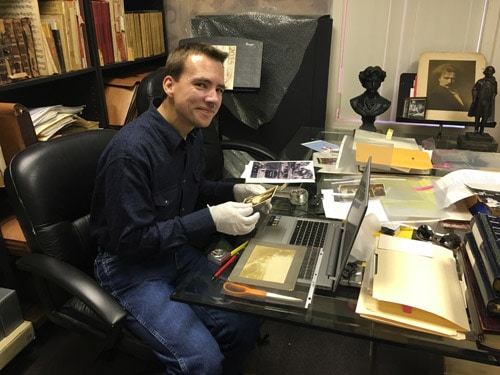
"My dear Paderewski, I can assure you that Poland will resurrect and will exist again"again"n", announced the American President Woodrow Wilson.
„Mój drogi Paderewski, mogę zapewnić Pana, że Polska zmartwychwstanie i będzie znów istnieć”, zapowiedział amerykański prezydent Woodrow Wilson, polskiemu wirtuozowi. I słowa dotrzymał.
Photo: http://zs2.staszow.pl/ignacy-jan-paderewski.html
Polish Blue Army
“An independent Polish state should be erected. .. which should be assured free and secure access to the sea.. .”
Woodrow Wilson
The mass migration of Poles to the United States started in the 19th century and reached a peak in the first years of the 20th century. Polish immigrants came from their homeland, dismembered by neighboring countries. Poland was no longer on the map of Europe, but very much alive in the hearts of its people. Polish immigrants carried the flame of patriotism and the dream of independence with them to the United States.
In l9l4, the Polish community in North America began to organize in hopes of forming a military organization with a goal of fighting for Poland’s independence. Polish-Americans were eager to fight on the side of the Allies, but at that time, the United States was not a participant in World War I. Since Canada, then a British possession, was a World War I participant, in 1917, the Poles persuaded Canadians to train Polish officers, and a cadet school was set up in Cambridge Springs. Canadians granted permission to create the Polish army-in-exile, and set up a Polish Army Camp in Niagara-on-the-Lake, called “Camp Tadeusz Kosciuszko.” Over 20,000 men trained in Canada, and were-equipped and paid by France.
In April 1917, the United States declared war on the Central Powers. Earlier that year, Ignacy Jan Paderewski submitted a proposal in the U.S. House of Representatives to accept Polish-American volunteers for service on the Western Front in the name of Poland’s independence.
Thanks to various diplomatic efforts by Polish organizations, and the friendship between Paderewski and Woodrow Wilson, progress was made. The American President, in his address to Congress, declared among the objectives of the war: “An independent Polish state should be erected…which should be assured a free and secure access to the see…”
Afterward at the Congress of the Polish Falcons in the United States, Paderewski proposed that the Polish community would offer the Wilson administration a 100,000 strong Polish volunteer army, called the Kosciuszko Army. Polish-Americans were eager to fight for freedom and the American-style democracy; however, the Defense Department rejected the offer, fearing that it would lead to a fragmentation of the United States Army.
In June 1917, France sanctioned the formation of a Polish Army on French soil. A Polish military mission sailed from France to the U.S. to recruit volunteers and asked the U.S. authorities for permission to do so. It was granted, provided that no one eligible for recruitment into the United States Army, that is no U.S. citizen between the ages of 20 and 30, would be inducted.
The recruits, mostly Polish-Americans, were directed for training in Niagara-on-the-Lake, but, as the number of volunteers increased and the capacity of Niagara-on-the-Lake was exceeded, the U.S.
The government agreed to have the Poles also train at the New Fort Niagara Army base. They were provided blue French uniforms and subsequently got to be known as the “Blue Army” Eventually, some 24-000 recruits were trained in the two facilities and sent to France to join General Józef Haller.
The Blue Army, led by General Haller grew 100,000 strong and was considered by the countries of the Entente, the only Polish, independent army unit fighting side by side with the allies.
After fighting on the Western Front during World War I, the Blue Army was transferred to Poland and joined other Polish formations in fight for Poland’s independence. The Blue Army played a critical role in ensuring victory in the Polish-Ukrainian War and defeating Bolsheviks in the Polish-Soviet War.
Photo: General Józef Haller -„Wedding to the Sea”
In 1920-21, the majority of the Blue Army’s Polish-American volunteers returned to the United States. Unfortunately, they were not recognized as veterans by either the American or Polish governments.
Source: Zgoda, 2018, Issue No1








